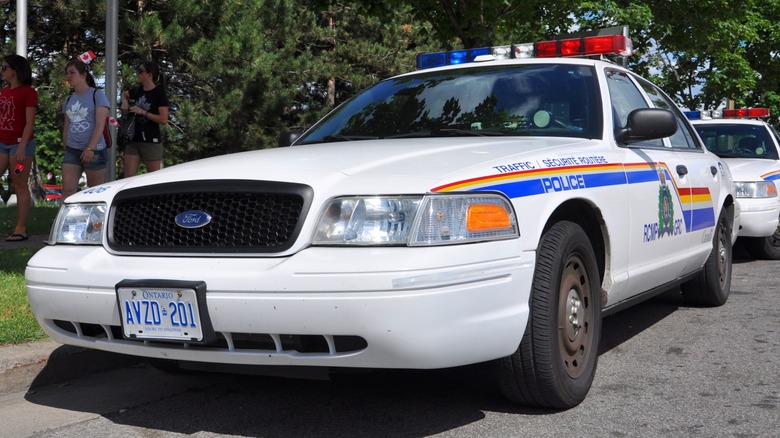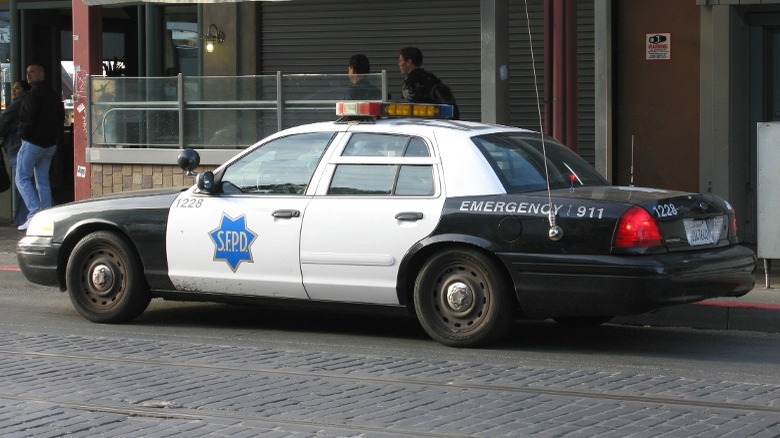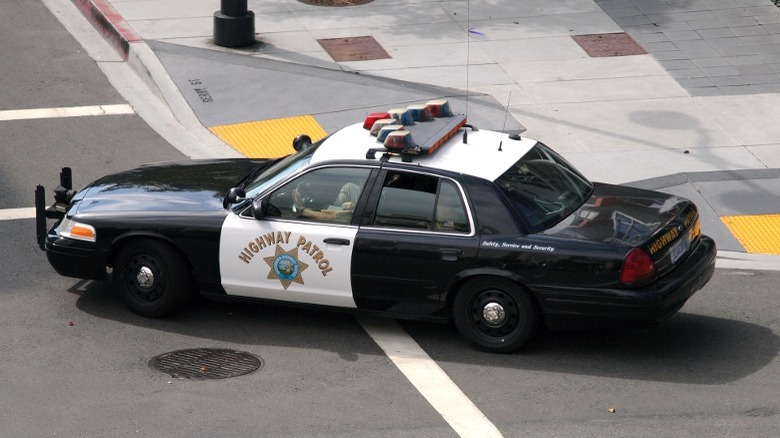What Was The 'P71' Crown Victoria, And How Fast Was It?
Newer generations of drivers may not know the name, but the silhouette of the vehicle has become indelible from the sheer number of images and movies it appears in — as a taxi, a family car, and a patrol car. The Ford Crown Victoria's shape has been seared into the mind's eye of many. From 1991 to 1997, Ford produced the first generation of this large, ultra-reliable sedan for families and fleets. It was built on Ford's Panther platform, a body-on-frame design that debuted in 1979 under the LTD, Marquis, and Continental. The automaker was so pleased with the platform that Ford also used it for the Lincoln Town Car and Grand Marquis.
Its size, dependability, and affordability made it a no-brainer for police departments as well, so Ford created a modified version called the Crown Victoria Police Interceptor (CVPI) or P71. The vehicle fit the bill so well, it became almost the default police car for the U.S. and Canada. A second-generation Crown Victoria was built between 1998 and 2011, and was sold to fleets only. With its restricted class of buyers, the P71 adopted the Police Interceptor trunk badge in 1998 to replace the Crown Victoria badge.
The P71 (called the P7B in the last two production years) was so beloved that when Ford stopped manufacturing the Crown Vic in favor of the Taurus, some police departments hoarded Interceptors.
What made the Crown Victoria a fleet vehicle favorite
The Crown Victoria was simply one of the most reliable cars Ford ever made. The vehicle could rack up hundreds of thousands of miles of heavy stop-start use. The original Crown Vic packed Ford's first overhead cam model under the hood — a modular 4.6-liter V8. While not crazy fast, it had endurance.
The P71 package included extra-heavy-duty engine cooling to handle demanding driving (car chases, endless stop-starts, and hours and hours of highway) and the range of climates that police patrolled in. It even stayed cool just idling during stakeouts, thanks to its external oil-to-coolant heat exchanger that kept the oil temperature in check.
Police magazine Blue Line extolled the many virtues of the P71, pointing out that body-on-frame construction was not only durable, but cheaper to repair after crashes and PIT maneuvers because the chassis didn't need to be straightened. The Crown Vic's rear-wheel-drive led to fewer spinouts and better curb-climbing while chasing bad guys as well. Added "severe duty" shock absorbers also took in those curbs and off-road bounces. In fact, the P71 was the only car the California Highway Patrol bought for patrols between 1996 and 2012.
How fast was the P71?
Of all the traits the Police Interceptor was known for, fast off the mark was not one of them. The behemoth weighed in at nearly two tons, so it was better at sustaining top speed than reaching it quickly. That said, the last model year (2007) with the 4.6L V8 non-Flex Fuel engine had a reported top speed of 137 mph.
By 2011, the P71 with a 4.6 Modular SOHC V8 engine cranking out 250 horsepower was said to have a top speed of around 140 mph. However, Blue Line reports that Interceptors after 2006 have speed limiters restricting them to 120 mph and/or 130 mph — depending on rear axle ratio.
Whatever the exact or official number, The P71 was fast enough. One officer said of his Crown Vic to Police1, "I chased a Ferrari one night on I-171 in Fort Worth and caught him. I let the guy go with a warning telling him I caught him with an old Crown Vic with over 100,000 miles on it."


